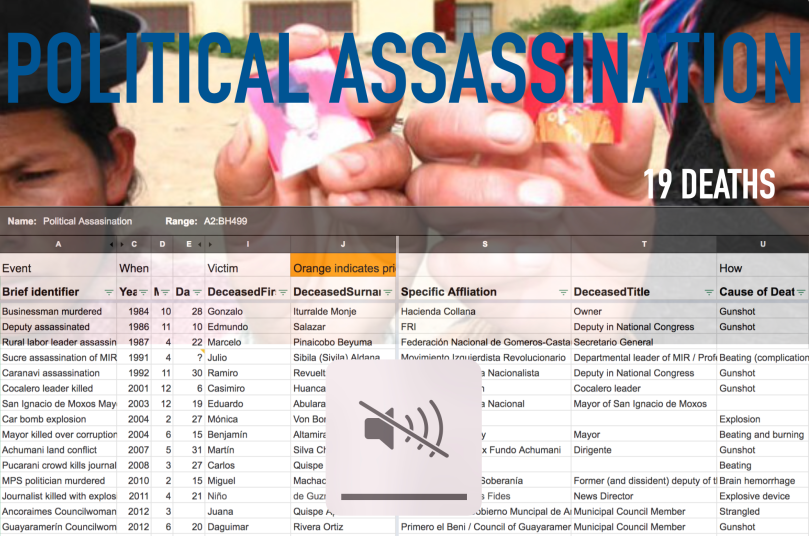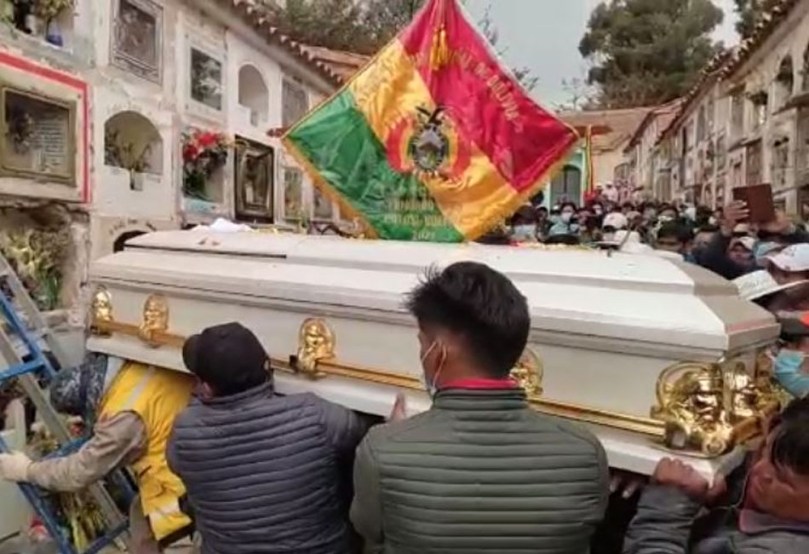Violent death cast a shadow over multiple social movements in Bolivia during the third calendar year of President Luis Arce. Deliberate killings came in clashes over land, mining, and the planned census, claiming eight lives, while tear gas detonated in a student meeting led to a stampede in which five were killed. A government bureaucrat who exposed a major corruption scandal died of years of mistreatment in prison. A motorcyclist was killed by a wire strung as part of a road blockade. And a brutal stabbing killed another participant in road blockades. Altogether, fifteen Bolivians lost their lives in or around Bolivia’s often charged movement conflicts.
The deadly events were as follows:
- La Estrella land clash, March 19: Intercultural farmers had moved on March 12 to occupy lands on the “La Estrella” ranch, owned by Jacob Ostreicher and subject to claims of money laundering in a 2011 case that attracted international attention. These land occupiers were attacked on March 19 by armed people, either farmworkers or hired attackers presumibly sponsored by in-country landowner Claudia Liliana Rodríguez. (Ostreicher remains in exile.) The attackers confronted the Intercultural squatters around 22:00, shooting rockets and firing firearms. Franklin Delgadillo, son of Intercultural leader Ricardo Delgadillo, was shot and killed. The Interculturales maintained a multiday blockade demanding justice afterwards. Police arrested at least nine people for the killing in March 2022.
- Death of imprisoned Indigenous Fund official, April 19: Marco Antonio Aramayo, the former director of Bolivia’s Fondo Indígena, died in custody following seven years of detention under an abusive avalanche of investigations in a scandal he himself brought to light. The Fondo Indígena, which Aramayo headed from 2013 to 2015, was intended to provide independent funding to indigenous communities for development and self-representation. Aramayo denounced in 2016 that the Fund was instead used by Minister Nemesia Achacolla as a slush fund during an election year.
While many have been accused of corrupt acts, Aramayo has borne the highest weight of prosecutions (over 250 investigations begun); he was convicted and sentenced to 5 years in 2017. ITEI, a Bolivian organization that supports victims of torture and state violence, issued a statement: Aramayo’s “death is the tragic conclusion of a series of violations of [his] fundamental rights,” “which affect [him] and also affect people deprived of liberty in general.” According to the ITEI, which has provided medical and psychological attention to him since 2017, police and penal authorities tortured Aramayo physically with beatings and stress positions; biologically by depriving him of food, water, or medicine; psychologically with threats, extortion, insults, and humiliation. Aramayo was repeatedly required to travel to attend new cases across the country, with the final one filed two weeks before his death. Exhausted from his ordeal, Aramayo died of multiple organ failure, aggravated by diabetes and hypertension.
While police announced an investigation into his death, his legal representative denounced that no actions had been taken three weeks later. - Potosí university stampede, May 9: A nightmarish stampede ensued at Potosí’s Tomás Frías University after a tear gas grenade was set off during an indoor meeting to convene university federation elections. Some five thousand students were reportedly in the coliseum. Many were injured in the rush to flee, including four who were killed that day and one more who died on June 15. Reportedly two of the dead were mothers who leave behind children. Six were sent to intensive care. Between 71 and 83 were wounded. The tragedy was apparently amplified by the locking of the main exit doors.
Bolivian student politics operates in close coordination with national political parities and is often highly contentious. The tragedy also put attention on student leaders who maintain student status over decades and accumulate patronage and power in on-campus political organization.Four students, at least two of them involved in student politics, have been arrested in connection with the gas release and its deadly consequences. The Minister of Justice names Manfred Flores Canaza as the “principal and material author” of the crime. - Tinguipaya clash, May 15: Two men died in fratricidal violence in the town of Tinguipaya, Potosí. The brawl between differently organized Indigenous people—ayllus vs. campesinos—followed a visit by Vice President Choquehuanca and involved stones, sticks, slingshots, and rockets. Ironically, Choquehuanca’s speech, marking the opening of a political training school, had called for cross-cultural unity and fearless speech. The cause of the conflict remains totally disputed: national MAS-IPSP official attributed it to a local land conflict, while some local figures and opposition politicians blamed internal partisan disputes within the MAS-IPSP linked to the local mayor. Police attempting to investigate the incident had difficulty entering the area in the following days.
- Chiñijo land clash, June 23: On June 23 a confrontation over land ownership in the community of Tamiplaya Tolapampa in Chiñijo, Sorata resulted in the beating deaths of two local campesinos and injury to an additional five. A group of 60 land-grabbers, hired and led by Gabriel Callisaya Toledo, Mario Luque, and Genaro Quito attacked the community in attempt to take their land, intimidating them with dynamite, dogs, and firearms. The General Secretary of Chiñijo, Susana Silva, claimed that Sorata police refused to provide assistance or to remove the bodies of the victims and only arrived at the on the 26th. Communities members protested by taking the victims’ bodies to Sorata in a protest march in order to demand justice. The community members possessed a resolution from the National Institue of Agrarian Reform (INRA) that recognized their right to the property and instructed the police to forcefully evict unlawful occupants.
- Mapiri mining cooperatives clash, June 24: A group of expelled members of the Hijos de Pueblo gold mining cooperative attacked the cooperative in the community of Charobamba, Mapiri, in an attempt to regain leadership. A local teacher, Faustino Nestor Maqui Chambi, was killed when he was hit in the head by a stone, causing him to fall from his boat and drown. Police arrested 7 or 8 of the agressors, but their convoy was attacked in Aguada while transporting the arrested persons to La Paz and one the arrestees escaped.
- Santa Cruz census strike, deaths on October 22, November 9 and 10: The Santa Cruz Civic Movement mounted a 36-day department-wide strike in protest of the delay of the Census to 2024, and demanding it be held in 2023. Clash between supporters of Santa Cruz general strike and those attempting to open blockades. During an October 22 clash on the Amistad bridge that connects Santa Cruz with Brazil, a municipal employee of Arroyo Concepción, Julio Pablo Taborga, suffered injuries from blows to his head. He was transported to a hospital in Puerto Quijarro where his death was recorded early the next morning. According to Taborga’s wife, he was demonstrating against the blockade when supporters of the strike arrived with dynamite and homemade bombs and began to beat him. Video of the confrontation appeared to show victim succumbing to tear gas rather than a beating. The Santa Cruz Civic Committee released a statement blaming the MAS for the conflict.
Eduardo Arancibia Barrancos was killed in the early morning of November 9 while driving a motorcycle to work. He attempted to drive through a blockade point in the Tres Lagunas neigborhood of Santa Cruz. He did not notice that a coaxial cable was stretched across the road between two poles. This cable cut through his upper neck as he drove, causing his death. Police arested five men who were maintaining the blockade point.
Overning on November 11, a group of four or five people attacked two men who were maintaining a blockade in the Barrio Latino of the Los Lotes zone of Santa Cruz. The attackers assaulted Jairo Montero, 21, and José Eduardo Sosa, 28, with knives, leaving Montero hospitalized with criticall injuries and Eduardo Sosa dead. The Sosa’s heart was reportedly cut out of his chest by the attackers. Two of the attackers were arrested on November 15.




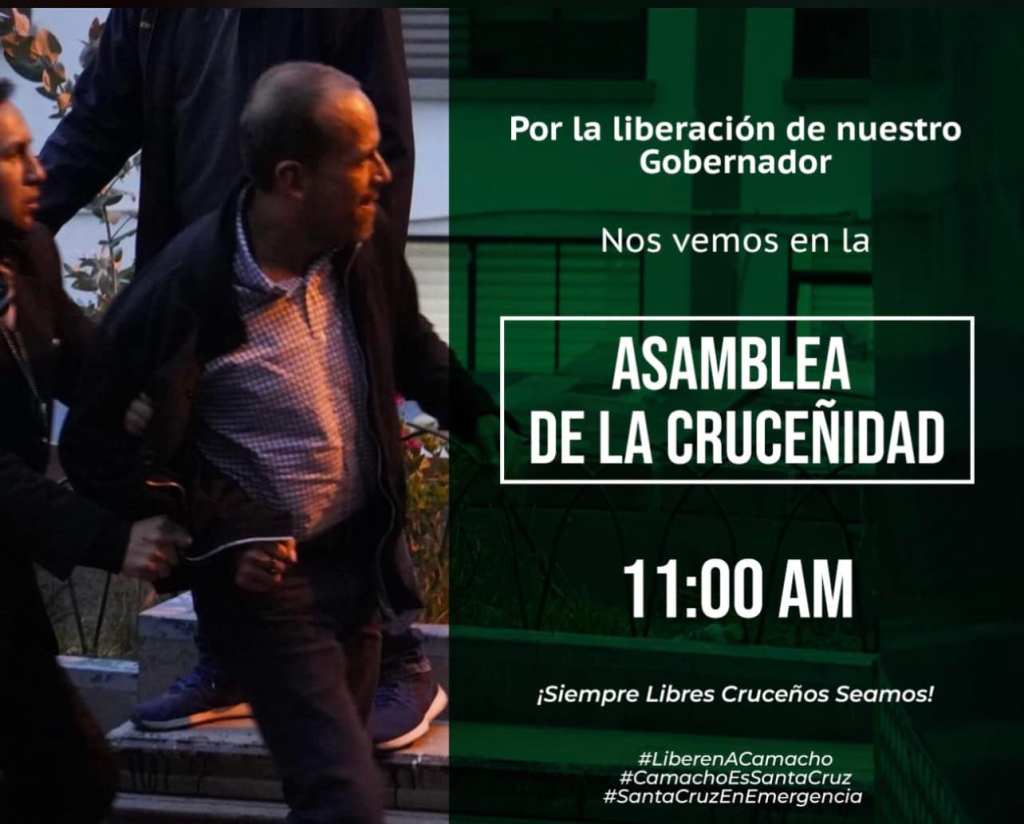
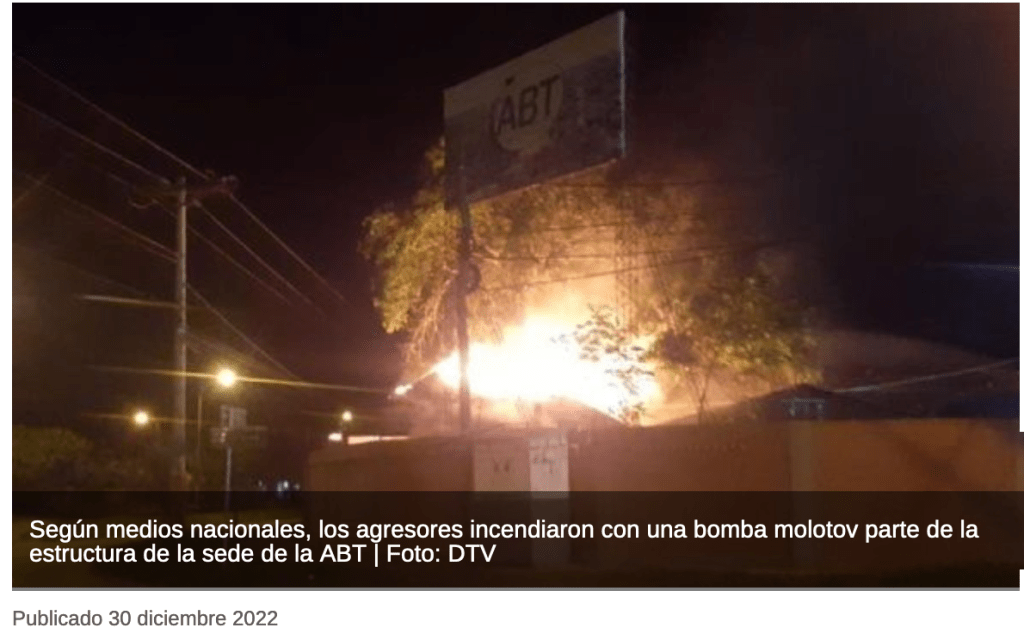

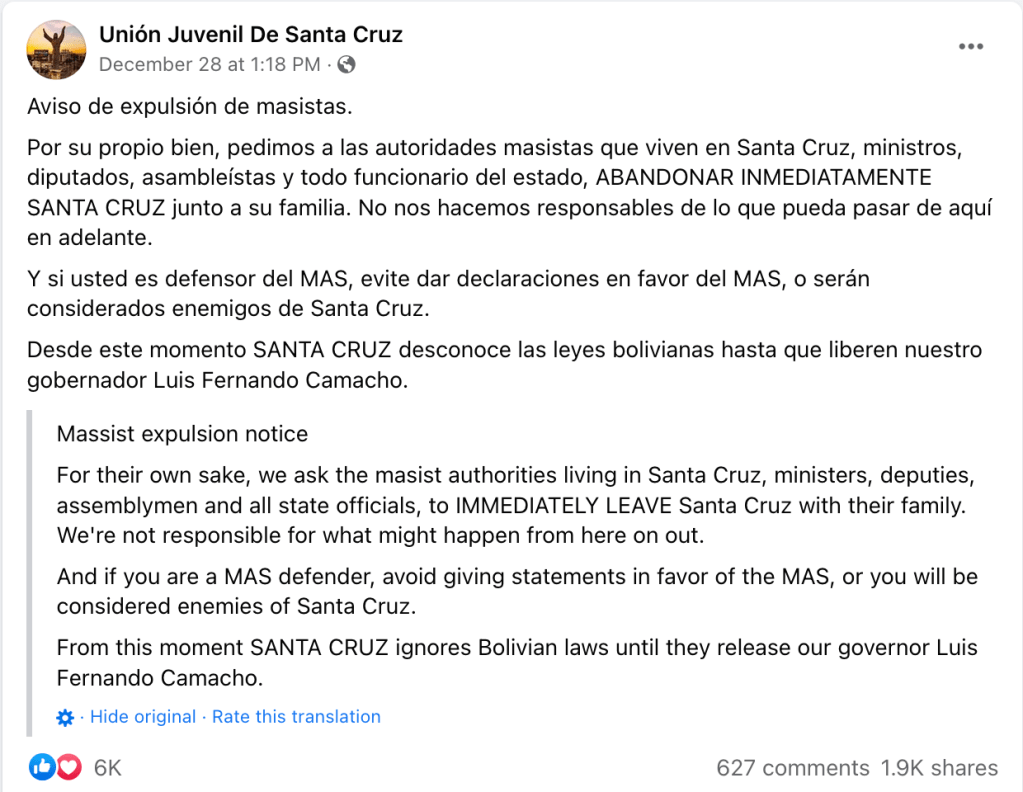
![A Facebook invite from Unión Juvenil Santa Cruz (not the official account of the UJC), reads, "Gran Bienvenida del 2023 / Recibamos este nuevo año a los pies del cristo / Desde los 22 horas / Entrada: Vinagre, mascara antigas, agua, balde, bicarbonato, palos, piedras, escudos, pinturas, petardos, etc. / Te esperamos!"
"Great Welcome to 2023 / Let's receive this new year at the feet of the Christ [the Redemeer statue] / From 10pm onwards / Entry fee: Vinegar, gas mask, water, bicarbonate, sticks, stones, shields, paint, rockets, etc! We're waiting for you!"](https://woborders.blog/wp-content/uploads/2022/12/screen-shot-2022-12-31-at-3.42.49-pm.png?w=1024)
